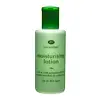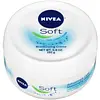What's inside
What's inside
 Key Ingredients
Key Ingredients

 Benefits
Benefits

 Concerns
Concerns

 Ingredients Side-by-side
Ingredients Side-by-side

Water
Skin ConditioningC12-15 Alkyl Benzoate
AntimicrobialGlycerin
HumectantParaffinum Liquidum
EmollientCetearyl Alcohol
EmollientGlyceryl Stearate
EmollientDimethicone
EmollientPEG-100 Stearate
Caprylic/Capric Triglyceride
MaskingPhenoxyethanol
PreservativePetrolatum
EmollientCaprylyl Glycol
EmollientSodium Benzoate
MaskingXanthan Gum
EmulsifyingEthylhexylglycerin
Skin ConditioningTocopheryl Acetate
AntioxidantCarbomer
Emulsion StabilisingPropylene Glycol
HumectantRetinyl Palmitate
Skin ConditioningPotassium Hydroxide
BufferingParfum
MaskingHexyl Cinnamal
PerfumingSorbitol
HumectantHydroxycitronellal
PerfumingCitronellol
PerfumingCucumis Sativus Fruit Extract
EmollientDenatonium Benzoate
MaskingTocopherol
AntioxidantBenzoic Acid
MaskingCI 19140
Cosmetic ColorantCI 42090
Cosmetic ColorantWater, C12-15 Alkyl Benzoate, Glycerin, Paraffinum Liquidum, Cetearyl Alcohol, Glyceryl Stearate, Dimethicone, PEG-100 Stearate, Caprylic/Capric Triglyceride, Phenoxyethanol, Petrolatum, Caprylyl Glycol, Sodium Benzoate, Xanthan Gum, Ethylhexylglycerin, Tocopheryl Acetate, Carbomer, Propylene Glycol, Retinyl Palmitate, Potassium Hydroxide, Parfum, Hexyl Cinnamal, Sorbitol, Hydroxycitronellal, Citronellol, Cucumis Sativus Fruit Extract, Denatonium Benzoate, Tocopherol, Benzoic Acid, CI 19140, CI 42090
Water
Skin ConditioningGlycerin
HumectantMyristyl Alcohol
EmollientParaffinum Liquidum
EmollientButylene Glycol
HumectantAlcohol Denat.
AntimicrobialStearic Acid
CleansingPetrolatum
EmollientMyristyl Myristate
EmollientGlyceryl Stearate
EmollientHydrogenated Coco-Glycerides
EmollientDimethicone
EmollientSimmondsia Chinensis Seed Oil
EmollientTocopheryl Acetate
AntioxidantLanolin Alcohol
EmollientPolyglyceryl-2 Caprate
EmulsifyingParfum
MaskingCarbomer
Emulsion StabilisingSodium Hydroxide
BufferingPhenoxyethanol
PreservativeWater, Glycerin, Myristyl Alcohol, Paraffinum Liquidum, Butylene Glycol, Alcohol Denat., Stearic Acid, Petrolatum, Myristyl Myristate, Glyceryl Stearate, Hydrogenated Coco-Glycerides, Dimethicone, Simmondsia Chinensis Seed Oil, Tocopheryl Acetate, Lanolin Alcohol, Polyglyceryl-2 Caprate, Parfum, Carbomer, Sodium Hydroxide, Phenoxyethanol
 Reviews
Reviews

Ingredients Explained
These ingredients are found in both products.
Ingredients higher up in an ingredient list are typically present in a larger amount.
Carbomer is a polymer of acrylic acid. Its main role is to create a gel consistency.
A high amount of carbomer can cause pilling or balling up of products. Don't worry, most products contain 1% or less of carbomer.
Dimethicone is a type of synthetic silicone created from natural materials such as quartz.
What it does:
Dimethicone comes in different viscosities:
Depending on the viscosity, dimethicone has different properties.
Ingredients lists don't always show which type is used, so we recommend reaching out to the brand if you have questions about the viscosity.
This ingredient is unlikely to cause irritation because it does not get absorbed into skin. However, people with silicone allergies should be careful about using this ingredient.
Note: Dimethicone may contribute to pilling. This is because it is not oil or water soluble, so pilling may occur when layered with products. When mixed with heavy oils in a formula, the outcome is also quite greasy.
Learn more about DimethiconeGlycerin is already naturally found in your skin. It helps moisturize and protect your skin.
A study from 2016 found glycerin to be more effective as a humectant than AHAs and hyaluronic acid.
As a humectant, it helps the skin stay hydrated by pulling moisture to your skin. The low molecular weight of glycerin allows it to pull moisture into the deeper layers of your skin.
Hydrated skin improves your skin barrier; Your skin barrier helps protect against irritants and bacteria.
Glycerin has also been found to have antimicrobial and antiviral properties. Due to these properties, glycerin is often used in wound and burn treatments.
In cosmetics, glycerin is usually derived from plants such as soybean or palm. However, it can also be sourced from animals, such as tallow or animal fat.
This ingredient is organic, colorless, odorless, and non-toxic.
Glycerin is the name for this ingredient in American English. British English uses Glycerol/Glycerine.
Learn more about GlycerinGlyceryl Stearate is a mix of glycerin and stearic acid.
It is used to stabilize the mixing of water and oil ingredients. By preventing these ingredients from separating, it can help elongate shelf life. It can also help thicken the product's texture.
As an emollient, it helps soften skin and supports barrier-replenishing ingredients.
In cosmetics, Glyceryl Stearate is often made from vegetable oils or synthetically produced.
This ingredient may not be fungal-acne safe
Fun fact: The human body also creates Glyceryl Stearate naturally.
Learn more about Glyceryl StearateParaffinum Liquidum is also known as liquid paraffin. It is a type of highly refined mineral oil.
Like other oils, Paraffinum Liquidum has emollient properties. Emollients help soothe and soften the skin. By creating a barrier to trap moisture within, emollients help keep your skin hydrated.
Paraffinum Liquidum does not irritate the skin and is non-comedogenic.
Learn more about Paraffinum LiquidumParfum is a catch-all term for an ingredient or more that is used to give a scent to products.
Also called "fragrance", this ingredient can be a blend of hundreds of chemicals or plant oils. This means every product with "fragrance" or "parfum" in the ingredients list is a different mixture.
For instance, Habanolide is a proprietary trade name for a specific aroma chemical. When used as a fragrance ingredient in cosmetics, most aroma chemicals fall under the broad labeling category of “FRAGRANCE” or “PARFUM” according to EU and US regulations.
The term 'parfum' or 'fragrance' is not regulated in many countries. In many cases, it is up to the brand to define this term.
For instance, many brands choose to label themselves as "fragrance-free" because they are not using synthetic fragrances. However, their products may still contain ingredients such as essential oils that are considered a fragrance by INCI standards.
One example is Calendula flower extract. Calendula is an essential oil that still imparts a scent or 'fragrance'.
Depending on the blend, the ingredients in the mixture can cause allergies and sensitivities on the skin. Some ingredients that are known EU allergens include linalool and citronellol.
Parfum can also be used to mask or cover an unpleasant scent.
The bottom line is: not all fragrances/parfum/ingredients are created equally. If you are worried about fragrances, we recommend taking a closer look at an ingredient. And of course, we always recommend speaking with a professional.
Learn more about ParfumPetrolatum is more commonly known as petroleum jelly. It is created by mixing waxes and mineral oils.
This ingredient is effective at reducing water loss by 99%. This is because it is an occlusive. Occlusives create a hydrophobic barrier on the skin to prevent evaporation. This property makes it great for hydrating dry skin.
Pro tip: Use occlusives, such as this ingredient, on damp skin for the best results.
The quality or origin of petrolatum is only known when disclosed by the brand. Most cosmetic petrolatum has gone through several purification stages.
Another benefit of occlusives is it protects your skin against infection or allergies.
Petrolatum may not be safe for fungal-acne. Studies show mineral oil / petroleum leads to the growth of M. Furfur, a type of yeast.
Learn more about PetrolatumPhenoxyethanol is a preservative that has germicide, antimicrobial, and aromatic properties. Studies show that phenoxyethanol can prevent microbial growth. By itself, it has a scent that is similar to that of a rose.
It's often used in formulations along with Caprylyl Glycol to preserve the shelf life of products.
Tocopheryl Acetate is AKA Vitamin E. It is an antioxidant and protects your skin from free radicals. Free radicals damage the skin by breaking down collagen.
One study found using Tocopheryl Acetate with Vitamin C decreased the number of sunburned cells.
Tocopheryl Acetate is commonly found in both skincare and dietary supplements.
Learn more about Tocopheryl AcetateWater. It's the most common cosmetic ingredient of all. You'll usually see it at the top of ingredient lists, meaning that it makes up the largest part of the product.
So why is it so popular? Water most often acts as a solvent - this means that it helps dissolve other ingredients into the formulation.
You'll also recognize water as that liquid we all need to stay alive. If you see this, drink a glass of water. Stay hydrated!
Learn more about Water